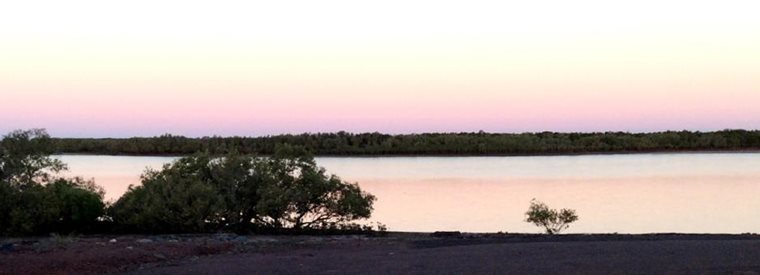.aspx) Tidal Pulse
Tidal Pulse
Lesley Munro
August 2014
Cossack. The name conjures up, for me, images of horsemen with sabres drawn, galloping over grassy plains. The rolling hills around the Pilbara town of Cossack would however leave some nasty Spinifex reminders for anyone who dared be so rash.
Set 50kms north of the City of Karratha, at the mouth of the estuary to the Harding River, the ghost town of Cossack has a vivid pearling and seaport history of its own. A cluster of historic buildings remain, including the solid Courthouse and Police lockup, Telegraph Station and the large Galbraith Store, which became a spacious classroom for my painting workshops and a place to work with noisy tools. The bluestone buildings begin a good stone’s throw from high water mark, wide enough to turn a camel train no doubt, but now a parking and boat ramp area, marking the site of my artist in residence studio for six whole weeks.
The tidal focus of the town was captivating. A rise and fall of nearly five metres daily meant that water levels viewed from my window rose and fell dramatically. Colours and forms changed rapidly, almost before my eyes, demanding a closer look.
.aspx) I would rise early, before sunrise if possible, to see the gold on gold of sky on water, separated by a black band of mangroves. Ten minutes later and throughout the day, a fugue of colours played constantly. In the tidal chase up the estuary, the sky appeared large only to retreat to intricate patterns on the beaches and the claypan along the causeway. Unable to capture enough of this feast of colour and pattern with my small studies, I photographed greedily, constantly, obsessively, trying to absorb this new world in front of me, and a full five weeks still to go!
I would rise early, before sunrise if possible, to see the gold on gold of sky on water, separated by a black band of mangroves. Ten minutes later and throughout the day, a fugue of colours played constantly. In the tidal chase up the estuary, the sky appeared large only to retreat to intricate patterns on the beaches and the claypan along the causeway. Unable to capture enough of this feast of colour and pattern with my small studies, I photographed greedily, constantly, obsessively, trying to absorb this new world in front of me, and a full five weeks still to go!
 Amidst the Cossack Art Awards and a procession of associated events, the population of the town swelled from a sum total of three to, at one time, a thousand, with the daily ebb and flow of visitors mimicking the rise and fall of a high spring tide. The pulse could be seen in the tiny tracks at Settlers Beach, in the presence then absence of guests in the guest house, the appearance or lack of pelicans in the claypans, and the changing size of the moon.
Amidst the Cossack Art Awards and a procession of associated events, the population of the town swelled from a sum total of three to, at one time, a thousand, with the daily ebb and flow of visitors mimicking the rise and fall of a high spring tide. The pulse could be seen in the tiny tracks at Settlers Beach, in the presence then absence of guests in the guest house, the appearance or lack of pelicans in the claypans, and the changing size of the moon.
Through this period my night painting workshops and several school workshops came and went, along with informal studio visitors inspecting my own captured versions of the tidal epic raging or sliding outside my window. Coloured painting water was retained and captured in plastic water bottles, colour placed against colour like the streams of opposing currents outside. Beautiful, subtle, seamless, but not enough. The concrete floor outside my window became home to strips of pristine watercolour paper anchored by stones, periodically flooded by colours seen or hoped for, staining the paper in patterns of its own.
A visit to local Indigenous art groups showed me the powerful expressions of country in the artwork of both senior and younger artists, reminding me it was eight years since my first visit to the area, during which the younger women have developed their own strong practices and the senior artists risen to even greater heights. Their confidence, embrace of experiment and skill in execution was impressive in their preparation of new work for upcoming Colours of Our Country Exhibition.
.aspx)
Meanwhile I continued to follow the tidal patterns, explore the claypans, the barren orange hills with their scrubby trees and clouds of Spinifex, all demanding investigation and yet more photography. Trying to memorize the landscape, to internalize the shapes and forms and colours that occupy these spaces, painting them into memory, drawing them into myself, finding a language of shapes and marks to connect me to this place. How to do justice to this remote and beautiful landscape!
As the six weeks inevitably rolled away and I waited among the yellow-vested throng at Karratha airport, I was able to reflect on my residency, on the land, on the artists and others that I met. They were without exception an inspiring bunch. Each with their own story or message to me, with their energy, their generosity and their plans. Whether in the burgeoning city of Karratha or ghosts of Cossack, cultural histories, or Roebourne concert night, I left inspired by the sense of energy and growth, and paradoxically a sense of changelessness.

Lesley Munro is an Artsource Plus Member. She was the winner of the 2013 Cossack Art Award and subsequent 2014 Cossack Artist in Resident. The residency is sponsored by Rio Tinto and managed by Pilbara based art consultancy and project management company, Archipelago Arts.
Artsource supports the practice of professional artists with the Global City Residencies.